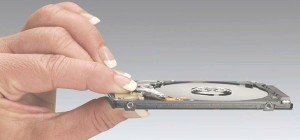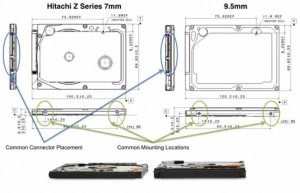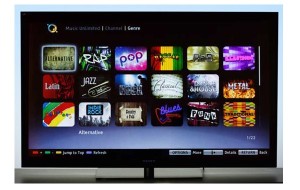It’s a new hard drive by Hitachi.This hard drive for ultra-light PCs that’s 26% thinner……

Collins said upcoming ultra-light notebooks for which the new drives are being produced target a market segment between low-end netbooks and high-end, ultra-thin notebooks, such as the Macbook Air. The ultra-light notebooks are expected to roll out in the third quarter of the year.
Hitachi’s new Z-series drives are .27-in thick and have a single spinning platter with up to 320GB capacity, the same capacity as the company’s .37-inch thick, single-platter predecessors. Collins said Hitachi is not releasing a suggested retail price because it sells to equipment manufactures or resellers, who then determine the pricing
Hitachi unveiled Tuesday its latest in ultraslim hard drives, the Z-series of TravelStar and CinemaStar. The TravelStar is for ultraportable computing devices, whereas the CinemaStar is for audio and video (AV) streaming.
Hitachi said the drive slim down was prompted by laptop manufacturers such as Dell, HP, Lenovo and Aser, which are all planning to produce thinner, lighter notebooks. The new hard drives, however, will serve multiple markets, including television set-top boxes and portable video players, Collins said.
It’s the world’s first 320GB hard disk drive to spin at 7,200 RPM in a 7-mm high package — take that Seagate. The 2.5-inch Serial ATA 3Gbps Travelstar Z7K320 features a 1,334Mbps max transfer rate assisted by a 16MB cache. The HDD draws 1.8 watts during read/write operations and 0.8 watts on lower-power idle while humming along at 23dB when idle or 24dB when seeking. And that skinny 7-mm form factor means it’ll go places no standard 9.5-mm thick drive could even dream of when it hits the mass production lines in August.
Despite the ultrathin design, the new Z-series hard drives share the same port configuration with other 9mm SATA hard drives and therefore can be used in any application where other 2.5-inch SATA hard drives are used.
The Z-series includes three drives: the Travelstar Z7K320, a 7200rpm drive with 16MB cache for use in higher-performance notebooks, ultra portables and netbooks; the Travelstar Z5K320, a 5400rpm drive with 8MB cache with lower power usage, lower cost and quieter acoustics for mobile and ultra-portables; and the CinemaStar Z5K320, a 5400rpm drive with 8MB cache for use in A/V streaming devices such as set-top boxes, portable video players, DVR-enabled TVs and video surveillance systems.
Hard drives with a single disk platter represent about 70% of the PC drive market today, according to Brendan Collins, vice president of marketing at Hitachi GST. Two-disk drives provide 1TB and 2TB capacities.
The new slimmer drives are mechanically compatible with their thicker predecessors, meaning their serial ATA connection and side mounting holes are the same so that the drives are interchangeable in laptops.
SSDs can be 17 times the cost of a hard disk drive and and 1.8-inch drives can be up to seven times more expensive on a cost-per-gigabyte basis when compared to the new Hitachi Z-series drives, the company stated in its marketing material.
According to market research firm Forward Insights, for PC, notebook and netbook manufacturers, SSD prices are around $1.90 per gigabyte today. Hard drives cost about 30 cents per gigabyte.
Hitachi says the new drives are currently shipping in volumes to OEM manufacturers, so it’s unclear how much they cost individually. However, according to Hitachi, they offers the most cost-effective storage solution in terms of cost per gigabyte, especially when compared with that of solid-state drives.
Resources :news.cnet.com,computerworld.com,engadget.com



Pingback: Gadgetsteria
Pingback: Seagate Momentus Hard Drive – 500GB – 5400rpm – Internal – Retail Compare Prices
Pingback: Dell 25 GB Serial ATA Solid State Hard Drive Reviews
Pingback: WD AV Hard Drive - 320GB - 7200rpm - Internal Reviews
Pingback: Dell 2 TB 7200 RPM Serial ATA Hard Drive Compare Prices
Pingback: Hitachi Internal Hard Drive - 320GB - 7200rpm - Serial ATA - 2.5" - Internal Reviews
Pingback: Dell 500 GB 7200 RPM Serial ATA Internal Hard Drive Reviews
Adquirí un Hitachi X320 . Excelente. Pero demora en aparecer en pantalla o retrasa el comienzo de uso de mi PC si está conectado. ¿Pueden Ayudarme? Mi E-mail es jezamtol@hotmail.com ¡¿Agradecido!